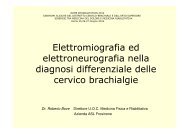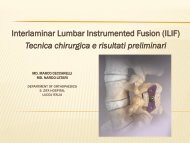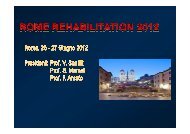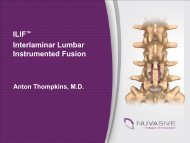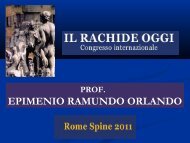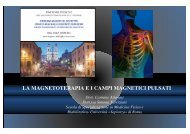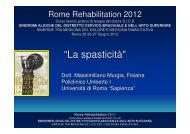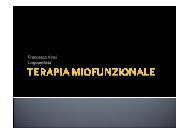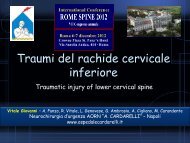Oswestry Disability Index - formazionesostenibile.it
Oswestry Disability Index - formazionesostenibile.it
Oswestry Disability Index - formazionesostenibile.it
- No tags were found...
Create successful ePaper yourself
Turn your PDF publications into a flip-book with our unique Google optimized e-Paper software.
FIRE STATION # 37 June 7, 2005STATE ROAD 54, PASCO COUNTY, FLORIDAINDEX TO SPECIFICATIONSSectionNo. OfNumber PagesDIVISION 0 -BIDDING AND CONTRACT REQUIREMENTSPrepared by Pasco County PurchasingDIVISION 1 - GENERAL REQUIREMENTS01010 Summary of Work 101300 Subm<strong>it</strong>tals 501410 Testing Laboratory Services 1601500 Construction Facil<strong>it</strong>ies/Temperature Controls 601600 Material and Equipment 301700 Contract Closeout 5DIVISION 2 - SITE WORK02010 Subsurface Investigation 202100 S<strong>it</strong>e Preparation 402220 Excavating, Filling and Grading 902270 Erosion, Sedimentation and Dust Control 102281 Term<strong>it</strong>e Control 402500 Asphalt Paving and Surfacing 502528 Concrete Walks and Curbs 202701 S<strong>it</strong>e Util<strong>it</strong>ies 202900 Landscape Work 7DIVISION 3 - CONCRETE WORK03100 Concrete Formwork 403210 Concrete Reinforcing 403250 Concrete Accessories 203300 Cast-In-Place Concrete 1403370 Concrete Curing 2DIVISION 4 - MASONRY04090 Masonry Accessories 604100 Mortar and Masonry Grout 404210 Clay Masonry Un<strong>it</strong>s 4i
ODIOSWESTRY DISABILITY INDEXFairbank J, Couper J, Davies J, O'Brien J.The <strong>Oswestry</strong> low back pain questionnaire.Physiotherapy 1980;66:271-73.Jeremy FairbankProfessor of Spine SurgeryOxford, UK
ODI version 2.1aSection 1 - Pain intens<strong>it</strong>ySection 2 - Personal care (washing, dressing, etc.)Section 3 - LiftingSection 4 - WalkingSection 5 - S<strong>it</strong>tingSection 6 - StandingSection 7 - SleepingSection 8 - Sex life (if applicable)Section 9 - Social lifeSection 10 - Travelling
Section 1 - Pain intens<strong>it</strong>y I have no pain at the moment. The pain is very mild at the moment. The pain is moderate at the moment. The pain is fairly severe at the moment. The pain is very severe at the moment. The pain is the worst imaginable at the moment.
Section 2 - Personal care(washing, dressing, etc.) I can look after myself normally w<strong>it</strong>hout causing extrapain. I can look after myself normally but <strong>it</strong> is very painful. It is painful to look after myself and I am slow andcareful. I need some help but manage most of my personalcare. I need help every day in most aspects of self care. I do not get dressed, wash w<strong>it</strong>h difficulty and stay inbed.
Section 3 - Lifting I can lift heavy weights w<strong>it</strong>hout extra pain. I can lift heavy weights but <strong>it</strong> gives extra pain. Pain prevents me from lifting heavy weights off the floor butI can manage if they are conveniently pos<strong>it</strong>ioned, e.g. on atable. Pain prevents me from lifting heavy weights but I canmanage light to medium weights if they are convenientlypos<strong>it</strong>ioned. I can lift only very light weights. I cannot lift or carry anything at all.
Section 4 - Walking Pain does not prevent me walking any distance. Pain prevents me walking more than one mile (1 Kilometre). Pain prevents me walking more than a quarter of a mile (500metres). Pain prevents me walking more than 100 yards (100 metres). I can only walk using a stick or crutches. I am in bed most of the time and have to crawl to the toilet.
Section 5 - S<strong>it</strong>ting I can s<strong>it</strong> in any chair as long as I like. I can s<strong>it</strong> in my favour<strong>it</strong>e chair as long as I like. Pain prevents me from s<strong>it</strong>ting for more than 1 hour. Pain prevents me from s<strong>it</strong>ting for more than half anhour. Pain prevents me from s<strong>it</strong>ting for more than 10minutes. Pain prevents me from s<strong>it</strong>ting at all.
Section 6 - Standing I can stand as long as I want w<strong>it</strong>hout extra pain. I can stand as long as I want but <strong>it</strong> gives me extra pain. Pain prevents me from standing for more than 1 hour. Pain prevents me from standing for more than half an hour. Pain prevents me from standing for more than 10 minutes. Pain prevents me from standing at all.
Section 7 - Sleeping My sleep is never disturbed by pain. My sleep is occasionally disturbed by pain. Because of pain I have less than 6 hours sleep. Because of pain I have less than 4 hours sleep. Because of pain I have less than 2 hours sleep. Pain prevents me from sleeping at all.
Section 8 - Sex life (if applicable) My sex life is normal and causes no extra pain. My sex life is normal but causes some extrapain. My sex life is nearly normal but is very painful. My sex life is severely restricted by pain. My sex life is nearly absent because of pain. Pain prevents any sex life at all.
Section 9 - Social life My social life is normal and causes me no extra pain. My social life is normal but increases the degree of pain. Pain has no significant effect on my social life apart fromlim<strong>it</strong>ing my more energetic interests, e.g. sport, etc. Pain has restricted my social life and I do not go out as often. Pain has restricted social life to my home. I have no social life because of pain.
Section 10 - Travelling I can travel anywhere w<strong>it</strong>hout pain. I can travel anywhere but <strong>it</strong> gives extra pain. Pain is bad but I manage journeys over two hours. Pain restricts me to journeys of less than one hour. Pain restricts me to short necessary journeys under30 minutes. Pain prevents me from travelling except to receivetreatment
0% = no disabil<strong>it</strong>y - “normal”100% = total disabil<strong>it</strong>y
ODI as a baseline assessment
In 1980 we suggested…0-20% Minimal <strong>Disabil<strong>it</strong>y</strong>20-40% Moderate <strong>Disabil<strong>it</strong>y</strong>40-60% Severe <strong>Disabil<strong>it</strong>y</strong>60-80% Crippled80-100% Exaggerating or Bedbound
In 2000 we reviewed >300 c<strong>it</strong>ationsFairbank J, Pynsent P. The <strong>Oswestry</strong> <strong>Disabil<strong>it</strong>y</strong> <strong>Index</strong>. Spine 2000;25:2940-53
ODI as a measure of change
2 year f/u data from MRC Spine Stabilisation Trial 2005
Some compet<strong>it</strong>ors…• Core Outcome Measures <strong>Index</strong> (COMI)• Roland Morris <strong>Disabil<strong>it</strong>y</strong> Questionnaire
Core Outcome Measures <strong>Index</strong>• Standardized set of outcome measures for use inpatients w<strong>it</strong>h back pain was proposed by amultinational group of experts• Deyo RA, Battie M, Beurskens AJHM, BombardierC, Croft P, Koes B, Malmivaara A, Roland M, KorffM, Waddell G. Outcome measures for low backpain research: a proposal for standardized use.Spine. 1998;23:2003–2013.doi: 10.1097/00007632-199809150-00018
Core Outcome Measures <strong>Index</strong>Used in SPINE Tango• The COMI has one question each on– back (neck) pain intens<strong>it</strong>y,– leg/buttock (arm/shoulder) pain intens<strong>it</strong>y,– Function– symptom-specific well being– general qual<strong>it</strong>y of life– work disabil<strong>it</strong>y– social disabil<strong>it</strong>y• scored as a 0–10 index
COMI
COMI• Standard outcome for Spine Tango• Needs to be completed in full
Roland Morris <strong>Disabil<strong>it</strong>y</strong> Questionnairehttp://www.rmdq.org/• Roland MO, Morris RW. A study of the naturalhistory of back pain. Part 1: Development of areliable and sens<strong>it</strong>ive measure of disabil<strong>it</strong>y in lowback pain. Spine 1983; 8: 141-144.• Selected questions from Pain <strong>Disabil<strong>it</strong>y</strong> <strong>Index</strong>• Does this apply to you now? yes– Score 0-24– Only scores marked questions ?missing data– Widely used– Advocated for primary care settings
ODI vs RMDQ
Scatter plot of simultaneous<strong>Oswestry</strong> <strong>Disabil<strong>it</strong>y</strong> <strong>Index</strong> vs Roland-Morris <strong>Index</strong> scoresIn a group of 100 back pain patients (via computer interview)<strong>Oswestry</strong> <strong>Disabil<strong>it</strong>y</strong> <strong>Index</strong>
Scatter plot of simultaneous<strong>Oswestry</strong> <strong>Disabil<strong>it</strong>y</strong> <strong>Index</strong> vs Roland-Morris <strong>Index</strong> scoresIn a group of 100 back pain patients (via computer interview)<strong>Oswestry</strong> <strong>Disabil<strong>it</strong>y</strong> <strong>Index</strong>
Scatter plot of simultaneous<strong>Oswestry</strong> <strong>Disabil<strong>it</strong>y</strong> <strong>Index</strong> vs Roland-Morris <strong>Index</strong> scoresIn a group of 100 back pain patients (via computer interview)Ceiling effect!<strong>Oswestry</strong> <strong>Disabil<strong>it</strong>y</strong> <strong>Index</strong>
Is RMQ better than ODI for lowdisabil<strong>it</strong>y studies in primary care?Frost H, Lamb S, Stewart Brown S.Responsiveness of a patient specific outcomemeasure compared w<strong>it</strong>h the <strong>Oswestry</strong> <strong>Disabil<strong>it</strong>y</strong><strong>Index</strong> V2.1 and the Roland and Morris <strong>Disabil<strong>it</strong>y</strong>Questionnaire for patients w<strong>it</strong>h sub-acute andchronic low back pain.Spine. 2008;33(22):2450-7.
Responsiveness of a Patient Specific Outcome MeasureCompared W<strong>it</strong>h the <strong>Oswestry</strong> <strong>Disabil<strong>it</strong>y</strong> <strong>Index</strong> v2.1 andRoland and Morris <strong>Disabil<strong>it</strong>y</strong> Questionnaire forPatients W<strong>it</strong>h Subacute and Chronic Low Back Pain
Surgical treatment of back pain –Baseline ODI scores
Surgical treatment of back pain55%40%
Surgical treatment of back pain?55%40%
Chiro ODI…..Zigler, J; Delamarter, R; Spivak, J; Linov<strong>it</strong>z, RJ;Danielson, GO; Haider, TT; Cammisa, F; Zuchermann, J;Balderston, R; K<strong>it</strong>chel, S; Foley, K; Watkins, R; Bradford,D; Yue, J; Yuan, H; Herkow<strong>it</strong>z, H; Geiger, D; Bendo, J;Peppers, T; Sachs, B; Girardi, F; Kropf, M; Goldstein, J.Results of the Prospective, Randomized, MulticenterFood and Drug Administration Investigational DeviceExemption Study of the ProDisc(R)-L Total DiscReplacement Versus Circumferential Fusion for theTreatment of 1-Level Degenerative Disc Disease.Spine 2007;32(11):1155-1162
Translations!!!
~44 translations of variable valid<strong>it</strong>yPlanned MAPI translations• Arabic for Kuwa<strong>it</strong>• Czech• English for Australia• English for Singapore• English for Canada• Dutch for Belgium• Dutch for the Netherlands• German for Austria• German for Sw<strong>it</strong>zerland• Hebrew• Korean for South Korea• Mandarin Chinese for Singapore• Polish• Portuguese for Portugal• Slovak
Please do not use Rogue ODI’s• Chiropractic• “modified” etc etc• Poor translations
What is Normal???• Using ODI to establish normal<strong>it</strong>y…
“Normal” ODI scores collected by Fairbank & Pynsent(The <strong>Oswestry</strong> <strong>Disabil<strong>it</strong>y</strong> <strong>Index</strong>. Spine (Phila Pa 1976.) 2000; 25(22): 2940-2952)• Mayo NE. Letter. Spine. 1995;20:1535–6.• Hupli M, Hurri H, Luoto S, et al. Isokinetic performance capac<strong>it</strong>y of trunk muscles:1. the effect of repet<strong>it</strong>ion on measurement of isokinetic performance capac<strong>it</strong>y oftrunk-muscles among healthy controls and two different groups of low-back painpatients. Scand J Rehabil Med 1996;28:201–6.• Hupli M, Heinonen R, Vanharanta H. Height changes among chronic low back painpatients during intense physical exercise. Scand J Med Sci Sports 1997;7:32–7.• Hupli M, Sainio P, Hurri H, et al. Comparison of trunk strength measurementsbetween two different isokinetic devices used at clinical settings. J Spinal Disord1997;10:391–7.• Kankaanpaa M, Taimela S, Webber CL, et al. Lumbar paraspinal muscle fatigabil<strong>it</strong>yin repet<strong>it</strong>ive isoinertial loading: EMG spectral indices, Borg scale and endurancetime. Eur J Appl Physiol Occup Physiol 1997;76:236–42.• Kankaanpaa M, Taimela S, Laaksonen D, et al. Back and hip extensor fatigabil<strong>it</strong>y inchronic low back pain patients and controls. Arch Phys Med Rehabil 1998;79:412–7.
‘Normal’ healthy populations (n=461) havean ODI mean score of 10 (SD 2-12)• “Successful Treatment” was defined as havingat one year follow-up
Functional status as measured w<strong>it</strong>h the ODI (0-100) inthe RealHealthNL study sample (n=524).
What is success?An alternative analysis• Current method:– Achievement of a given change-score, e.g. a 15-point reduction on a 0-100-scaled instrument• BUT achievement of such a change• 1) depends on the in<strong>it</strong>ial preoperative score• 2) does not indicate whether a satisfactory symptom state is ultimatelyreached• Material– 532 patients undergoing lumbar spine surgery in Oxford– ODI and the Core Measures Outcome <strong>Index</strong> (COMI) at various times upto 4y after surgery• “if you had to spend the rest of your life w<strong>it</strong>h the symptoms youhave right now, how would feel about <strong>it</strong>?”– 5-point Likert scale from “very satisfied” to “very dissatisfied”.
What is Normal???
Receiver Operating Characteristics (ROC)• Two analyses were used to derive cut-offscores for ODI that best predicted being 1)“satisfied” and 2) “very satisfied” w<strong>it</strong>h thesymptom state.Numbersof Patients“≥satisfied” 114/532(21%)“very 43/532satisfied” (8%)ROC areaunder thecurve95% CI ODIscorecutoffSens<strong>it</strong>iv<strong>it</strong>ySpecific<strong>it</strong>y0.89 0.86-0.92 ≤ 29 88%75%0.94 0.92-0.96 ≤ 14 86%89%
In 1980 we suggested…0-20% Minimal <strong>Disabil<strong>it</strong>y</strong>20-40% Moderate <strong>Disabil<strong>it</strong>y</strong>40-60% Severe <strong>Disabil<strong>it</strong>y</strong>60-80% Crippled80-100% Exaggerating or Bedbound
http://www.mapi-trust.org/• Copyright holders have licensed MAPI to care for ODI• No cost to clinical users, but do need to sign agreement• Some costs for publication and for commercial users.• Check MAPI Trust webs<strong>it</strong>e for correct versions andtranslations• Currently there are >44 translations, but few of thesehave been approved by MAPI yet• MAPI PROinformation@mapi-trust.org• Use version ODI v2.1a• Other webs<strong>it</strong>es/translations– Are considered to be in breach of copyright




